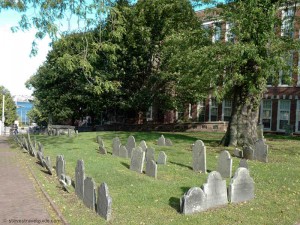Select your language to auto-translate:
Site of British Battery During Battle of Bunker Hill
Founded in 1659, Copp’s Hill’s permanent residents include the Puritan ministers Increase and Cotton Mather, Robert Newman (the patriot who hung the lanterns that signaled “two if by sea” in Old North Church), and Prince Hall, the father of Black Freemasonry.
Free – public park Closed as it gets dark Official website:
http://www.cityofboston.gov/parks/hbgi/CoppsHill.asp
Handicap access limited as it is up a steep hill from Old North Church and there are several steep granite steps to climb in order to enter the burying ground. No restrooms
Public transportation: Green or Orange line to North Station.
Plan 10-15 minutes to walk through and view the grave sites.
Background Information
Copp’s Hill Burying Ground, the second oldest in Boston, was founded in 1659. It takes its name from William Copp, the North End shoemaker who was the original owner of the land. The hill is the highest in the North End and originally was the sight of windmills, the source of its original name of Windmill Hill. The burying ground was extended several times as the need increased. The earliest grave markers date to 1661.
On the Snow Hill Street side are the many unmarked graves of the African Americans who lived in the “New Guinea” community at the foot of the hill. In addition to the graves, there are 272 tombs, most of which bear inscriptions that are still legible.
Among the Bostonians buried here are the family of the original owner, William Copp, as well as Robert Newman (the Sexton of the Old North Church who hung the “two if by sea” signal lanterns). Also here is Prince Hall along with many unmarked graves of African Americans who lived on Copp’s Hill. Prince Hall was one of the most influential free black leaders in the late 1700s. Hall is known for his work for education rights, as an early abolitionist, and as the father of Black Freemasonry.
The most historically significant memorial is the Mather Tomb, the final resting place for Increase (1639-1723) and his son Cotton Mather (1663-1728). Both Mathers were powerful and politically active ministers of the Old North Meeting House (Boston’s Second Church), which was in North Square by the Paul Revere House. They were directly involved in the hysteria surrounding the Salem witch trials which damaged their reputations.
When the British occupied the city during the Siege of Boston, in 1775-1776, Copp’s Hill Burying Ground was used for target practice. You can still see impact marks from British musket balls, particularly on the headstone of Captain Daniel Malcom. There’s even one in the eye of the skull!
Copp’s Hill was also the site of British cannons that were mounted to protect the harbor. During the Battle of Bunker Hill, these cannons were used to bombard Charlestown prior to the British assaults. You can see the Bunker Hill Monument and the USS Constitution from the back of the Burying Ground.
Narrowest House
Diagonally across the street from the Burying Ground entrance is the narrowest house in Boston. It is 10.4 feet (3.16 m) at its widest, it tapers to 9.2 feet (2.82 m) at the back. It was allegedly built as a “spite house” a little after 1874.















